Section Topics
Using InterAction Contacts in a Mail Merge
Microsoft Word provides options for performing mail merges. Performing a mail merge in Microsoft Word involves the following basic steps:
-
Create a data source with information about each recipient, such as names and addresses.
-
Create a main document. This document contains the static text you want for all recipients, and placeholders representing the data in the data source.
For example, the document might include a placeholder such as <<MailingAdrFormatted>>, which represents a contact’s mailing address.
-
Run the merge. Word creates a new document based on the main document and replaces the placeholders with values from the data source.
For example, the field <<MailingAdrFormatted>> would be replaced with the actual mailing address for each contact in the data source.
Note: For more about the mechanics of a mail merge, see Microsoft Word Help.
Microsoft Word provides a wizard to walk you through setting up a mail merge. You can look up a set of InterAction contacts to use as the data source. You can search in any of the following lists:
- My Contacts (i.e., your contact list) and the contact lists of anyone for whom you are a proxy
- The Firm List
- Marketing Lists
- Working Lists
If your organization has licensed any InterAction Related Modules – InterAction Matters, InterAction Opportunities, or InterAction Engagements, you can search contacts in these lists as well.
Tip: This section discusses launching a mail merge from within Microsoft Word. You can also launch a mail merge right from the Web Client. See Create Letters, Envelopes, or Labels from a List of Contacts.

Mail Merge Helper Button - Word
The Mail Merge button is available from both the Mailings tab and the InterAction tab.
See the following topics:
- Use InterAction Contacts in a Word Mail Merge
- InterAction Fields Available for a Word Mail Merge
- Building a List of Contacts for a Mail Merge
- Using a Word Mail Merge to Send Email Messages
- Use InterAction Contacts in a Distribution List Merge
- Reusing a Merge Document
Use InterAction Contacts in a Word Mail Merge
Tip: This section discusses launching a mail merge from within Microsoft Word. You can also launch a mail merge right from the Web Client. See Create Letters, Envelopes, or Labels from a List of Contacts.
-
In Word, choose the Mail Merge Helper button. For Word, this is available from the InterAction group on the Mailings tab.
InterAction displays the Choose Contacts for Mail Merge dialog box.
-
If you are working on behalf of another user, select that user’s name from the Search on behalf of list.
If you select to work on behalf of another user, the lists you can search reflect that user. For example, searching My Contacts will search the contact list of the other user rather than your own contacts.
-
Choose the tab for the list(s) you want to search for the contact.
You can choose from the following:
- My Contacts
- Firm List
- Marketing Lists
- Working Lists
-
Any licensed InterAction Related Modules (such as Matters)
-
If you want to change the version of data to insert (your version or the firm’s version), choose Actions > Preferences and select the appropriate radio button.
-
Enter search criteria for the contacts and choose Search.
-
In many cases, you might select a complete list, such as a category in your My Contacts list, or a specific working or marketing list.
-
There are different options available depending on the tab you chose in the previous step. For example, when searching My Contacts, you can select a specific category, whereas when searching the Firm List you can select a contact type. For details, see Entering Search Criteria in the Find Contact Dialog Box.
-
You can set an option to determine which version of the information is used in your mail merge. For details, see Selecting the Contact Data to Use.
-
-
In the Contacts grid, select each contact you want to include in the merge by selecting the check box next to the contact (Finding Contacts for a Mail Merge), then choose OK.
-
To select all the contacts in the list, choose Options > Check All.
-
Alternately, you can build a list of contacts from multiple searches. See Building a List of Contacts for a Mail Merge.
-
-
Word starts the Mail Merge Wizard. Complete each step of the wizard to create the main document for the merge.
-
If prompted for a data source, accept the default. This should be the export file created by InterAction.
-
To insert the InterAction data in your main document, you need to insert merge fields. The steps to do this depend on your version of Microsoft Word. See Microsoft Word Help for details.
-
In addition to creating form letters, you can use Word’s mail merge features to send e-mail messages to a group of recipients. See Using a Word Mail Merge to Send Email Messages.
-
-
If you want to reuse the main document (for example, for a mailing that you do on a regular basis), save the file. For more about re-using the document, see Reusing a Merge Document.
-
Complete the merge.
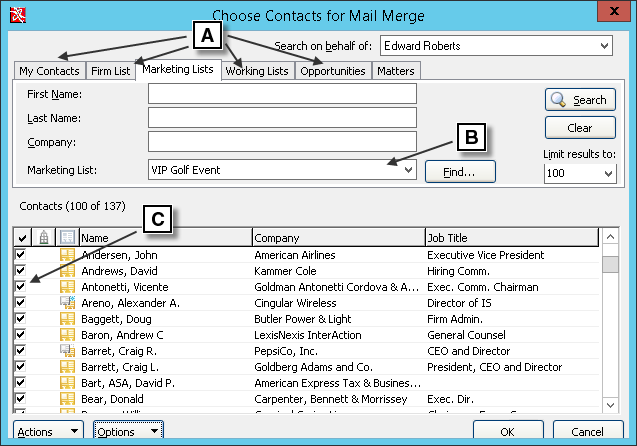
Finding Contacts for a Mail Merge
[A] Choose the type of list to search.
[B] Frequently, you do a mail merge for an entire list in InterAction. Depending on the tab you are using, you can select a list here. In this example, all contacts on the VIP Golf Event marketing list are found.
[C] Check the boxes to select the contacts to include in your merge.
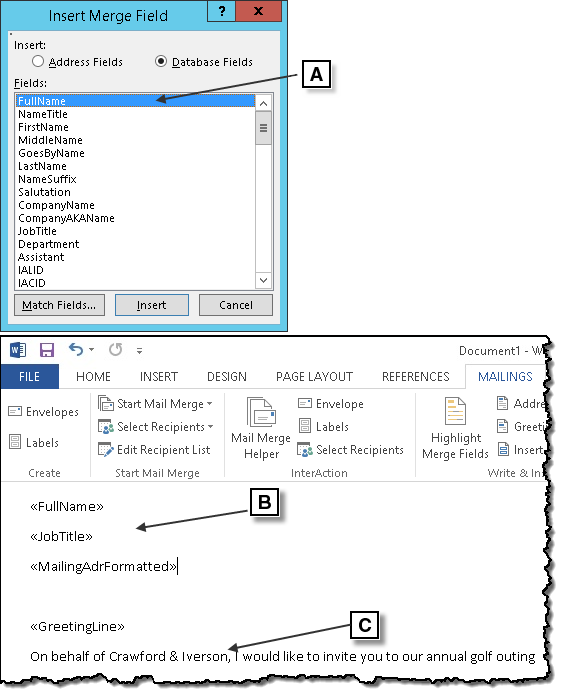
Creating the Main Document in Word
[A] Word dialog box for selecting merge fields to insert. The fields shown are the fields exported from InterAction.
[B] Merge fields in the Word document.
[C] Static text that remains the same for each letter.
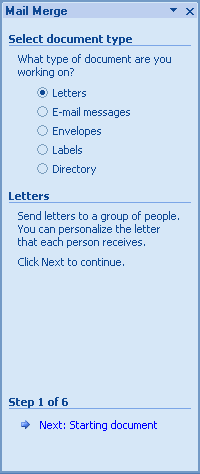
Mail Merge Helper in Word
InterAction Fields Available for a Word Mail Merge
When you set up your main document in Word, you can insert the data exported from InterAction. The following InterAction fields are available for use:
Name Fields
- FullName
- NameTitle
- FirstName
- MiddleName
- GoesByName
- LastName
- NameSuffix
- Salutation
- CompanyName
- CompanyAKAName
- JobTitle
- Department
- Assistant
- IALID
- IACID
- CompanyID
Phone Fields
- BusinessPhone
- BusinessFax
- BusinessPager
- BusinessMobile
- BusinessPhone2
- BusinessAsst
- BusinessEMail
- BusinessWeb
Mailing/Business Addresses
- MailingAdrType
- MailingAdrGeneralType
- MailingAdrLine1
- MailingAdrLine2
- MailingAdrLine3
- MailingAdrCity
- MailingAdrState
- MailingAdrPostalCode
- MailingAdrCountry
- MailingAdrFormatted
- BusinessAdrLine1
- BusinessAdrLine2
- BusinessAdrLine3
- BusinessAdrCity
- BusinessAdrState
- BusinessAdrPostalCode
- BusinessAdrCountry
- BusinessAdrFormatted
Home Information
- HomePhone
- HomeFax
- HomeAdrLine1
- HomeAdrLine2
- HomeAdrLine3
- HomeAdrCity
- HomeAdrState
- HomeAdrPostalCode
- HomeAdrCountry
- HomeAdrFormatted
- HomeEMail
Other
- OtherPhone
- OtherPhone2
- OtherFax
- OtherAdrLine1
- OtherAdrLine2
- OtherAdrLine3
- OtherAdrCity
- OtherAdrState
- OtherAdrPostalCode
- OtherAdrCountry
- OtherAdrFormatted
- OtherEmail
- Custom1
- Custom2
- Custom3
- Custom4
- Roles
- Responsibility
Building a List of Contacts for a Mail Merge
If necessary, you can build a list of contacts from multiple searches. This is useful if the contacts you want to include in the merge cannot be found with a single set of criteria. For example, suppose you want to send a mailing to all the people who work at two different companies. Both sets of contacts are not on any list together, so there is no single search criteria that would find all of them at once.
To accomplish this, do the following:
-
Start the InterAction Mail Merge Helper as described in Use InterAction Contacts in a Word Mail Merge.
-
Choose Options > Enable List Builder.
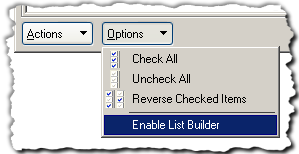
-
Enter criteria to find the first set of contacts.
-
Select the contacts to include in the list by selecting the check boxes next to the contacts, then choose Add to add them to the list shown at the bottom of the dialog box.
-
Change the search criteria as needed to find the next set of contacts, then repeat step 4. You can do as many searches as you need to build the list.
-
When you are finished building the list, choose OK to export the selected contacts for the mail merge.
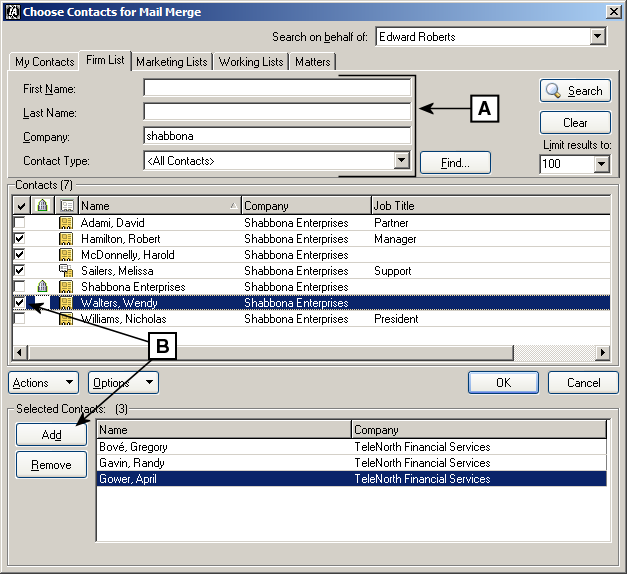
[A] Enter search criteria to find the contacts to include.
[B] Select the contacts and choose Add to add them to the running list of contacts.
Using a Word Mail Merge to Send Email Messages
In addition to creating letters and labels, you can use Microsoft Word’s mail merge capabilities to send email messages to multiple recipients. When you do this, Word sends an individual message to each recipient, which is useful if you need to send a message to a group, but don’t want the recipients to see all of the other recipients.
To send e-mail messages using Microsoft Word, use the InterAction Mail Merge Helper as described in Use InterAction Contacts in a Word Mail Merge. After finding and selecting the contacts to include in the merge, use the Word tools to create your message and send it to the recipients. The specific steps depend on your version of Word.
Microsoft Word
-
In the first step of the wizard, select E-mail messages as the document type.
-
Complete the remaining steps of the wizard. When you complete the last step, Word prompts for the field that contains the recipients’ email addresses. Typically this is BusinessEMail.
See Microsoft Word Help for more details about mail merging to email messages.
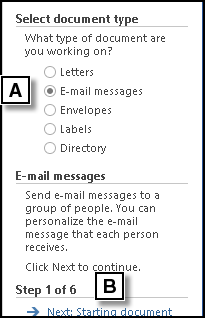
Merging to Email Messages in Word
[A] Selecting to merge to email in Word.
[B] Follow the remaining steps in the wizard to write and send the messages.
Use InterAction Contacts in a Distribution List Merge
Note: The following section only applies if your organization has licensed one of the InterAction Related Modules (Opportunities, Engagements, or Matters).
Opportunities, engagements, and matters can have distribution lists. Sometimes the contacts in these lists must be arranged in a particular order. When you select to use a distribution list for a mail merge, you can choose to use this special order rather than normal alphabetical order.
-
Start the mail merge as described in Use InterAction Contacts in a Word Mail Merge.
-
Select the appropriate tab for your Related Module (Opportunities, Matters, or Engagements).
-
Select the name of the Opportunity, Matter, or Engagement from the drop-down list or choose Find to look up the item.
-
Select the distribution list from the Show drop-down list and choose Search.
-
The contacts on the list are displayed in the custom order. Note that the grid includes an Order column on the right. Sort by this column to maintain the custom order. Note that the Order column does not appear if the list is not configured to use a custom order.
-
By default, all contacts on the list are already selected.
-
-
Choose OK to export the selected contacts and complete the merge.
Note: Note that you determine whether a distribution list uses a custom order when creating or editing the distribution list itself.
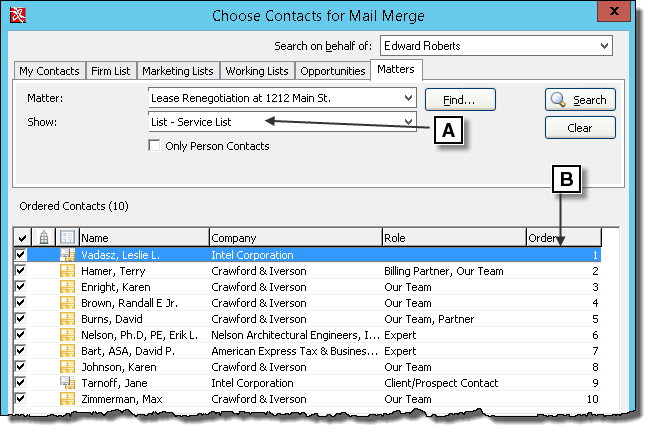
Distribution List with a Custom Sort Order
[A] Select the distribution list from the Show drop-down list.
[B] Since this list has a custom order, the Order column is included. Sort by this to maintain the custom order for the contacts.
Click the column header to reverse the sorting.
Reusing a Merge Document
When you save a merge document in Word, the location of the CSV file exported from InterAction is saved with it. Therefore, next time you open the document, Word looks for this file. If it still exists on your computer, the document is “ready to merge” with the already-exported data. If you open it on a different machine, the location is not valid and the document will be unable to connect to the data source.
In most cases, you don’t want to re-run the merge with the original data since the data may be out-of-date. Alternatively, you may want to run the merge with a different set of contacts. To do this, do the following:
-
Open the saved document in Word.
-
If prompted that Word can’t find the data source, choose Options, then choose to Remove Data/Header Source. This removes the references to the old exported file without changing anything else in the document.
-
Choose the Mail Merge Helper button from the InterAction toolbar.
-
Follow the steps to find the contacts and do the merge as described in Use InterAction Contacts in a Word Mail Merge.
InterAction exports the new set of contacts.
-
When completing Word’s Mail Merge Wizard, select to use the current document as the main/starting document in the merge.
Word then connects the newly exported contacts to the existing document as a data source.
